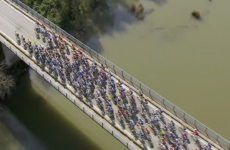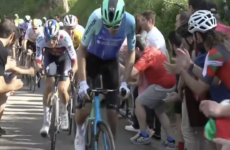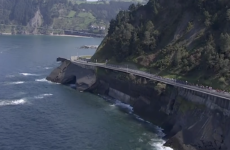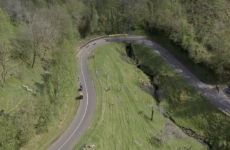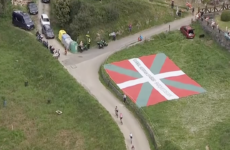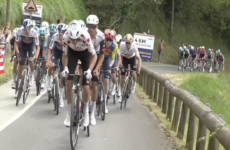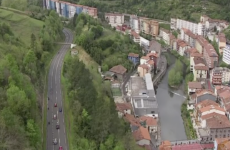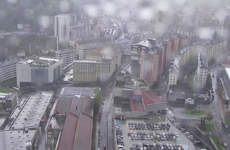Description
April 9, 2025
64th Itzulia Basque Country 2025 🇪🇸 (2.UWT) ME – Stage 3 – Zarautz – Beasain : 156,6 km
The Tour of the Basque Country (Officially: Itzulia Basque Country) is an annual road cycling stage race held in the Spanish Basque Country in April.
Show more...
April 9, 2025
64th Itzulia Basque Country 2025 🇪🇸 (2.UWT) ME – Stage 3 – Zarautz – Beasain : 156,6 km
The Tour of the Basque Country (Officially: Itzulia Basque Country) is an annual road cycling stage race held in the Spanish Basque Country in April. It is one of the races that make up the UCI World Tour calendar. As the Basque Country is a mountainous area, there are few flat stages, and thus the event favors those who are strong climbers. The race is characterized by its short stages, rarely exceeding 200 km, and steep ascents. While the ascents featured in the race are not particularly high compared to other stage races, they are among the steepest seen in professional cycling, some having sections with gradients reaching well above 20%.
It’s been an up and down day for Alex Aranburu (Cofidis). After crossing the line solo to win stage 3 of the Itzulia, he celebrated his accomplishment but before he could get to the podium ceremony, he learned that France’s Romain Grégoire (Groupama-FDJ) was declared the winner of stage 3 with the jury deeming Aranburu went the incorrect way around a roundabout, getting an unfair advantage.
Television footage released after the disqualification showed Aranburu clearly going off course at a point around 800 metres from the line, where the race route was not fully barriered, to head on a right-hand direction, also shorter, round the roundabout.
Hours later, after several objections, the jury decided to return the stage victory to Aranburu because the signage on the course pointed him in the direction he went.
The jury’s statement read, “Following the initial footage received, we made the decision to disqualify rider number 51 for ‘Deviation from the race route constituting an advantage,’ as the images appeared to show that the rider had taken the roundabout in a way that was deviating from the signposted route.
“However, after receiving and reviewing additional evidence, including data from Veloviewer, the roadbook, and the team, it became clear that all available information indicated that the roundabout in question was to be taken in the manner chosen by the Cofidis rider.
“In accordance with Article 1.2.064 of the UCI regulations, which states that ‘Riders shall study the course in advance’. In this case, the rider correctly followed the indicated path.”
Apparently, there was a signage error at the roundabout in question, and the Commissaires’ Panel overturned their initial relegation and restored the faultless Aranburu, who attacked in the closing kilometres of the hilly 157-kilometre stage to win solo in Beasain.
Grégoire was returned to second place on the stage, having led the peloton across the finish line three seconds behind the Spaniard.
Race leader Max Schachmann (Soudal-QuickStep) snatched valuable bonus seconds by finishing close behind Grégoire.
“I saw that he attacked with about a kilometre to go, João Almeida [UAE Team Emirates] was closing the gap, then there was a roundabout to the left, then we didn’t see him after that,” Grégoire told Eurosport later.
“I was just focussed on the rider ahead of me, I don’t know if there was any race signage. Even if I win, it’s not a real victory.”
Gregoire’s bemusement at taking the win was visible in his muted celebrations on the winner’s podium.
“It’s a very bizarre situation, I don’t really have the sensation of having won,” Grégoire said a little later. “[But] I think the commissaires have done their job, I’ve seen the replay, and I could see how he gained a margin. Those moments were decisive.”
How it unfolded
If the end of the stage was mired in controversy, two riders failed to begin what proved to be a non-stop day of race action on Wednesday’s hilly trek: both the previous day’s winner and points classification leader Caleb Ewen (Ineos Grenadiers) as well as Visma-Lease a Bike all-rounder Victor Campenaerts, who crashed late on stage 2.
After a blisteringly-fast start for the stage with over 3,000 metres of vertical climbing, Bruno Armirail (Decathlon AG2R La Mondiale) managed to go clear on the second of the day’s classified ascents, the grindingly long, if never overly steep, category 3 Andazarrate.
By the summit of the 13.4km climb, the French National Time Trial Champion had opened up a gap of over a minute, and despite some powerful counterattacks by riders like Quinn Simmons (Lidl-Trek), Armirail maintained that narrow advantage deep into the race’s second hour and a seemingly never-ending series of heavily wooded hills.
Armirail’s lone effort eventually petered out at the stage’s halfway point at the foot of the last category 2 climb of the Mandubia, and some initial skirmishing between the GC favourites began for the first time in the 2025 race. Isaac del Toro (UAE Team Emirates-XRG), Sepp Kuss (Visma-Lease a Bike) and Aleksandr Vlasov (Red Bull-Bora-Hansgrohe) tested the waters early on the climb and three kilometres from the top a more concerted effort went clear with João Almeida (UAE Team Emirates), Florian Lipowitz (Red Bull-Bora-Hansgrohe) and Ilan Van Wilder (Soudal-QuickStep).
With more than 70 kilometres to go, it was hard to conceive such a major overall bid truly going the distance. Yet even so, the chasing was so intense to bring that attack back in, that even though it proved successful, the pursuit reduced the front group down to just 30 riders.
On a day of non-stop attacking, UAE, obviously under instructions to keep the pressure on, promptly opted to fire Marc Soler up the road and the Catalan, just 28 seconds ahead on GC, was joined by Rudy Molard (Groupama-FDJ) and Clement Berthet (Decathlon-AG2R), as the trio headed onto a series of flatter valley roads.
But on the short but painfully steep Gainza climb that followed, first Molard and then Soler cracked as the pace slowed to 10 kph or less between two massive lines of cheering fans, leaving Berthet as the only rider ahead of a much-reduced peloton.
Schachmann intelligently tried to get the chase going and gain time on his rivals with an attack at 25km to go, and although around a dozen riders followed in his wake, it split an already fragile mini-bunch almost completely.
At the foot of the Lazkaomendi, with slopes rising up to a jaw-dropping 24%, Berthet’s crumbling advantage stood at a scant 16 seconds, only for Harold Tejada (XDS-Astana) to open up the chase, followed by Schachmann and Lipowitz.
Berthet was finally caught, but Lipowitz’s driving acceleration that followed caused plenty of gaps to open, particularly when Schachmann then opted for another drive of his own. Suddenly Almeida burst out of the pack with 4.5km to go and flying down the descent, Almeida was quickly joined by Aranburu, with a pack of 10 riders further back.
Almeida miscalculated at a curve, allowing Aranburu to gain more time as he went on the right side of a roundabout. But his daring move to victory ended in disaster when the commissaires decided that his shortcutting the route on that right side, as the course signage pointed to the left side, was worth a relegation, giving Grégoire a very unexpected win.
Results :












